
|
Sale 75
September Pre Long Beach
| Lot |
Photo |
Description |
Realized |
Lot 2116 |
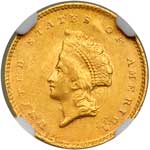 |
1855-C. NGC graded MS-61. Nice even gold toning. Only 9,803 struck. Attractive and very scarce. It is plain to see that care was taken in its acquisition, with an eye for detail and historical significance, all of which will redound to the buyer. A bright coin soaking up mint glow on warm orange gold surfaces with nothing to censor it from its refined grade. The only weak spot in the strike is seen at the topmost hair and decorative headdress feathers. This is a trait with most all Type 2 Gold Dollars due to their high relief Liberty head and thin planchets. Problems striking these, especially at Dahlonega and Charlotte branch mints, gave impetus to the Mint to redesign the issue in 1856.
Upon receiving his post to Mint Director in 1853, Colonel James R. Snowden readied plans to modify the gold dollar that James B. Longacre had created in 1849. To this end, Longacre increased the diameter of the denomination from 13 to 15 millimeters and reduced the thickness proportionately. At the same time, he used the opportunity to refashion both the obverse and reverse devices. The chief engraver altered the gold dollar's resemblance to the double eagle when he utilized his replica of the marble Venus Accroupie from the Three-dollar gold piece. The wreath of corn, cotton, maple, and tobacco that Longacre would in due course immortalize on the Flying Eagle cent also made the move from the Three-dollar gold piece to the new gold dollar. Once the Treasury Department agreed to the new design, coinage began on August 19, 1854. Soon, however, daily production runs laid bare the new design's shortcoming: The relief of the obverse motif was too high and Longacre had situated it opposite the highest points of the reverse. This created poor metal flow into the die cavities and even the capable Philadelphia Mint could rarely generate fully struck examples. Most pieces emerged from the Mint with weak devices and rapidly wore down to illegibility. The barely identifiable survivors that the Mint retrieved from circulation were melted as hastily as they had been designed, according to some sources. After two years of production at Philadelphia and token outputs at the branch mints that extended into 1856, Longacre reworked the denomination and created the Type Three gold dollar.
The 1855-C is the rarest collectible gold dollar from the Charlotte Mint in higher grades. A dozen or so accurately graded Aus are known as well as a scattering of Mint State coins; the appearance and poor manufacture of this date make it extremely difficult for any but the grading service experts to grade. This is certainly among the finest 1855-C gold dollars that have been made available to collectors in many years and it is a highlight of the Gold Dollar section, these are rarely ever sold at public auction. Pop 8; 4 finer in 62. (PCGS # 7533) Estimated Value $24,000 - 25,000
View details and enlarged photos
Check results on similar lots
| Unsold |
Lot 2117 |
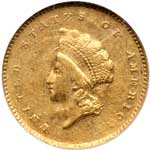 |
1855-C. NGC graded AU-58. Mostly untoned. Only 9,803 minted. Original gold luster with light planchet roughness, strictly as minted. A few very minor abrasions and hairlines are noted. Typical uneven strike for the issue although most of the main legends and date are clear. This is an exceptional higher grade example. Very few from the original mintage grade better than Extremely Fine. In other words, any strictly Extremely Fine or better example is a legitimate rarity.
Three pairs of dies were shipped from Philadelphia, including obverses, as the earlier Liberty head styles last used in 1854 were no longer available. Apparently, two obverse dies were employed and but a single reverse, that having the mintmark in a very small letter.
The prime focal points in the gold dollar series are the issues struck at the branch mints in Charlotte, North Carolina, and Dahlonega, Georgia. In the present era, coins from these mints are presented rarely.
The Charlotte Mint was authorized by Congress in 1835, and had certain operations underway in 1837, although the opening did not occur until 1838. Gold denominations eventually coined there included $1 (beginning in 1849), $2.50, and $5.
A good deal of the gold deposited at the mint came from the hills of North Carolina, long a source for gold bullion from the 1820s to the 1860s. Deposits were found in streams, embankments, and in tunneled mines. In the early years, quantities of the precious metal were shipped to the only federal mint then in operation, that at Philadelphia, a journey involving loss of time and exposure to danger. A miner or mining operator desiring to send gold to Philadelphia for coinage had to wait multiple weeks before it was returned in coin form. Once the Charlotte mint opened for business in 1838, production increased rapidly. Pop 33; 15 finer, 3 in 60, 8 in 61, 4 in 62 (PCGS # 7533) Estimated Value $14,000 - 15,000
View details and enlarged photos
Check results on similar lots
| Unsold |
Lot 2118 |
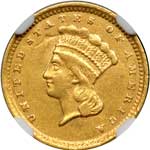 |
1857-C. NGC graded AU-53. Mostly untoned. Light golden color with remaining luster. Light planchet roughness is noted, apparently as struck. This example survives from an original mintage of 13,280 coins. A scarce coin in any grade. Douglas Winter suggested that only 100 to 110 coins survive, with only 10 to 13 examples better than EF45.
1857-C is important as the first Charlotte issue of the Type 3 design, none having been coined in 1856. By this time the demand for the gold dollar denomination must have been waning, perhaps due to the proliferation of pieces made in the same state by Bechtler. Whatever the indication, those depositing gold bullion called for higher denominations during this period, most often the half eagle. As it developed, no gold dollars were struck in 1858 either.
Among 1857-C gold dollars there are three die varieties, each of which has a significantly larger mintmark than seen on the next earliest issue, the 1855-C (PCGS # 7545) Estimated Value $2,600 - 2,700
View details and enlarged photos
Check results on similar lots
| Unsold |
Lot 2119 |
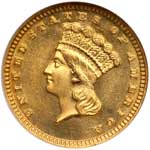 |
1884. NGC graded MS-67. CAC Approved. A glittering jewel! The watery surfaces are blemish free and radiate with semi-prooflike fields. An immaculate specimen and we cannot see how a finer business strike could exist in spite of the population reports. Will probably be re-graded for a higher grade. Housed in an Old Style Holder. Only 5,230 struck. Pop 14; 8 finer, 1 in 67 Star, 5 in 68, 1 in 68 Star, 1 in 69. (PCGS # 7585) Estimated Value $4,000-UP
View details and enlarged photos
Check results on similar lots
| Realized
$4,600 |
Lot 2120 |
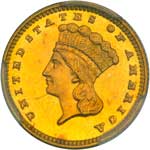 |
1887. PCGS graded Proof 64. Beautiful golden-orange russet color. A fine hairline appears in the left field through the jar. This was probably the result of a piece of lint present on the planchet when struck. Only 1,043 minted. Official Mint records indicate that Proof Gold Dollars were produced in every years from 1858 to 1889 (the last year in the series), with some earlier Proofs or specimens noted as well but not made available to the general public. We have no reason to doubt this 1887 is right on the cusp of Gem condition. As with Proof issues of many other gold denominations produced, the Gold Dollar had a limited distribution to generally wealthy collectors that led to the melting of many unsold examples. Fewer than half of the original 1887 mintage is thought to have survived. Estimates on the number of survivors in today's hobby vary, although the low PCGS census can tell us a lot. Pop 23; 21 finer, 13 in 65, 7 in 66, 1 in 67. (PCGS # 7637) Estimated Value $4,000 - 4,400
View details and enlarged photos
Check results on similar lots
| Unsold |
Lot 2121 |
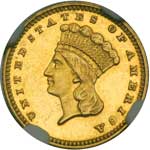 |
1887. NGC graded Proof 64 Cameo. A pleasing brilliant Proof specimen with a hint of delicate golden-orange toning. Only 1,043 struck. Choice Proof Gold Dollars of this caliber are difficult to find and while this 19th century issue is not a low-mintage issue, take a closer examination of its aesthetic and technical expertise, for they are meaningful. A coin that is fresh and nice and one many will consider to be at the top end of its range. Pop 15; 24 finer, 9 in 65, 11 in 66, 2 in 67, 2 in 68. (PCGS # 87637) Estimated Value $4,000 - 4,500
View details and enlarged photos
Check results on similar lots
| Realized
$4,830 |
|
|